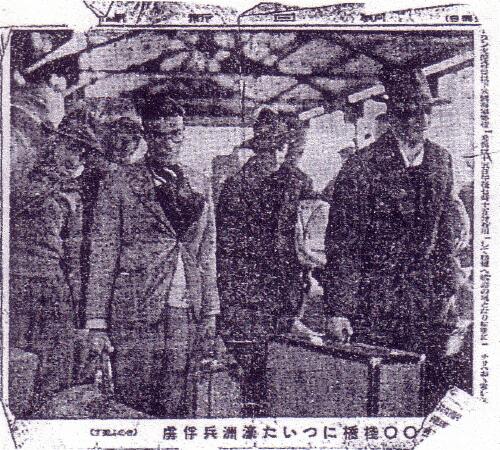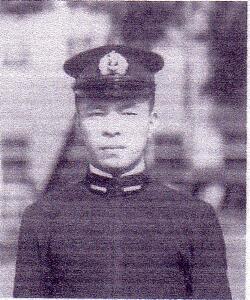|
Source: Gillespie, Oliver A., The
Pacific, War History Branch, Dept of Internal Affairs,
Wellington, NZ, 1952, p 233; letters from
Kevin Menzies.
The
islands described herein [Gilbert Islands] are now known as the nation
of Kiribati. An excellent reference
is the
book, "Conflict
in Kiribati" by Peter McQuarrie, Univ of
Christchurch, NZ.
The seven Coast Watchers from New Zealand captured in the Makin Atoll
were:
Captured on Bikati:
1. Michael Menzies, Pvt., NZEF, and his brother....
2. Jack M. Menzies, Pvt., NZEF
3. John M. Jones, a civilian Radio Operator
Captured on Little Makin (Makin Miang):
4. Pvt. Basil (Pat) Were
5. Pvt. L.E.H. Muller
6. Cpl. M.P. McQuinn- actually a civilian but retroactively made Army
Corporals to prevent execution as a spy.
Captured on Abaiang:
7. Cpl. Sydney R. Wallace- also
a civilian but retroactively made Army Corporals to prevent execution
as a spy.
Captured in the village of Butaritari:
(Not a
Coast Watcher)
8. Charles Fulford-Williams, Civil Administrator
American Captured in China:
9. RM1c Arthur H. Griffith, USN, American Consulate, Tsingtao -
[treated as a Diplomat and exchanged on the first POW exchange, June
1942, SS Gripsholm.]
The
Coast Watchers and Fulford-Williams were held in a tin shed at On
Chongs wharf on Butaritari until transferred aboard a
Japanese minesweeper to Juliet Island on 27 Dec 1942. From Juliet
Island, the men were sent to Yokohama in hold of the Yamagiri
Maru.
Kevin Menzies, son of Michael
Menzies,
Pvt., NZEF, stated in letter of 9 June 2000:
"My
father was captured [as a Soldier/Coast Watcher in the Gilbert Islands]
on the islet of Bikati, the northern tip of the Makin Atoll, on
10 Dec 1941 and [later] began his incarceration in
the University of Life at Zentsuji. He and his comrades, including his
brother Jack M. Menzies, were among the first Allied prisoners in
Japan, arriving in Yokohama on 7 Jan 1942. The American Marine from
Tsingtao [Griffiths] joined them on 10 Jan 1942. When he would talk
about [his experiences], (not often) he would tell of how he was in
Zentsuji when in the middle of the night he was [wakened] by the
Marines from Guam entering the camp. From then on, Dad built up strong
bonds with these men which never left him. He told me, not long before
his death, that often at night he lay awake and pictured all of their
faces."
Assorted information on
Michael Menzies
Questionnaire,
5th March 1947 (DOC file)
NOTE: "A warning with these is that my father said immediately after
the war when interviewed that they tended to downplay things. For
example, he seriously believed that the Japanese would rise again and
come after him, so did not want to antagonise them."
Summary
of the Facts and Evidence Relating to the Massacre of British
Nationals, Prisoners of War and Civilian Internees, by the Japanese at
Betio, Tarawa, on 15th October, 1942 (18 October 1944, PDF
file)
NOTE: This is the official report into the murder of 17 NZ coast
watchers and 5 civilians at Tarawa on Oct 15 1942. "My father in the
NZers in Zentsuji were part of this coast-watching group. These men
were their friends and comrades." See also this
article published by Taylor & Francis in the JOURNAL OF PACIFIC HISTORY, on 15TH
May 2018: "Peter McQuarrie and I wrote this story about where the
coast-watchers were killed on Tarawa, where the bodies were buried and
where their bones may be."
Notes on
Diary of Capt. M. P. Murphy (Singapore-Zentsuji), by Kevin Menzies
(DOC files)
NOTE: Murphy was a British officer incarcerated at Zentsuji.
BELOW PHOTO: "Picture of the NZers (including Dad) and
American Arthur Griffiths being transferred from the Dennison House
Yokohama to Zentsuji POW camp. This was taken about 14 Jan 1942. They
were the 1st Allied POWs into Japan, and as such, for a week were well
treated and photographed (propaganda) before arriving at Zentsuji a few
hours prior to the Guam POWs."
 Menzies transfer to Zentsuji
Menzies transfer to Zentsuji
(Asahi News 16th Jan. 1942; from Mr. Williams)

Hajime Shindo - "our Navy escort from Yokohama-Zentsuji, plus 2 guards"

Mainichi Nichi Nichi News, Jan. 1942Notes on below photos by Kevin Menzies:
Tomorrow (Dec. 11), mid-morning (in my head I think
9.30-10.30am
from what I have been told), it is 69 years to the day that Dad, Uncle
Jack (NZ Army) and John Jones (NZ Post Office), stood on the beach with
their backs to the Pacific Ocean and watched as the Japanese marines
landed at the southern end of Bikati, an island at the northern tip of
the Butaritari atoll.
The beach photo was taken at approximately 9.30 in the
morning, at the point where they stood, looking towards the
southern tip. Johnny Jones told me that there was less
vegetation in those days and that they could see the Japanese marines
advancing through the trees.
The Japanese came onto the coastwatchers small compound and began
ransacking. It was only after a few minutes that they actually saw the
coastwatchers no more than 50 metres away.
They lined up and shouting "Banzai," they bayonet-charged the
coastwatchers, stopping short, by millimetres, of killing them. My
father was knocked to the ground (I have heard said variously, that he
was pistol whipped and/or knock down with the butt end of a rifle...who
knows what weapon it was for sure, as time and trauma can affect one's
memory. All I do know is that my father never forgot it and nor did
Uncle Jack or Johnny Jones). Cito Teaki told me she saw the Japanese
kicking Snowy (my father).
Thus, the first of the NZ coastwatchers were captured.

Bikati - Standing looking where the NZers
watched
the Japanese advance from the far point
 Cito Teaki - Saw Menzies being kicked
Cito Teaki - Saw Menzies being kicked
We believe that they were the first POW's shipped to
Japan. They arrived in Yokohama on Jan 6th or 7th on the
Yamagiri (sp?) Maru. The first night they stayed at the
Yokohama Race Course. In the morning, off in the distance,
they saw what they believed were other Europeans in civilian clothing.
They were then taken to the Dennison House at The Bluff, Yokohama. Here
they were joined by an American radio operator from the embassy in
Tsingtao, Arthur Griffiths.
They spent about a week here, where they were photographed for
propaganda purposes (film and still photographs). Apparently some
Argentine newspapers might have given these pictures extensive
coverage. They were well looked after with good food and served by
ladies in kimonos. They knew it could not last and thought
that it might be a precursor to their execution.
But no, they were to be work horses, slowly ground down. On Jan 15th,
they arrived at Zentsuji after a 12-hr. train journey on public
transport (train) where once again they were photographed. After a few
hours, once they were asleep, they were awoken by American voices --
the Guam POW's had arrvived. Close bonds were formed, as Dad once told
me just before he died: "...I often lie awake at night and picture the
boys... I can remember their faces.." He then reeled off some names.
My own view of Zentsuji is that whilst it was at the "good" end of the
Japanese POW camp system, in reality it was not a lot different from
most others in Japan. A lot seems to have depended on each
camp's physical location. Zentsuji was more in a rural environment away
from the main centres of industry. Early it was good and a lot of
people judge it on that basis. But later on it became very bad, like
everywhere else. I guess that it is relative. Good in a bad
situation is still bad.
That in a nutshell is basis of the beginning of their incarceration. It
is all so sad really -- they were barely out of boyhood. They
were a group of 24 captured NZ coastwatchers. The other 17 were
beheaded. Of all coastwatchers captured in the Pacific, these are the
only ones that I know of who were not executed.
|




